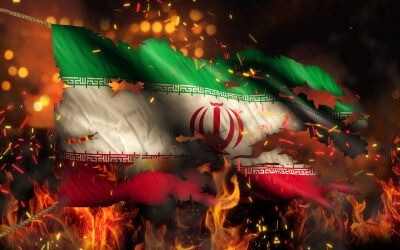Iran is worried that several recent incidents in the country point to a growing chance that the two-month-old protests are becoming dangerously violent.
For the regime, the protests become problematic when the violence spills over and when the protesters are armed.
An article in Iranian pro-Islamic Revolutionary Guard Corps media on Thursday indicated that the media narrative, spun from the top levels of government, will now hyper-focus on armed attacks by the protesters. Iran calls these groups “separatists,” a term it generally uses for Kurds, Baloch, Arabs and other minority groups in Iran.
The regime faces unrest from minorities
Not only is Iran a diverse country but minority groups may outnumber Persians, meaning that the regime has to balance the fact that it is rooted in the Persian theocratic elites, with the support it needs from minorities.
The largest minority groups are generally concentrated in various periphery regions of Iran; such as Kurds in the northwest, Azeris in the northwest, Balochis in the southeast as well as Arabs in the southwest. There are also populations of Lurs, Turkmen and other groups.
According to reports, gunmen attacked a bazaar in southwest Iran this week. There have also been armed clashes in Zahedan and areas where the Baloch minority are present.
The fact remains that the Kurdish community doesn’t need to mobilize to oppose the regime — the average person does that just fine.
Iran also carried out rocket and drone attacks on Kurdish groups in Iraq.
The regime believes dozens, or even hundreds of Kurdish activists have crossed from Iraq into Iran and that these “separatists” are involved in mobilizing opposition to the regime.
The fact remains that the Kurdish community doesn’t need to mobilize to oppose the regime — the average person does that just fine.
There are a plethora of Kurdish groups that operate in Iraq and among Kurdish Iranian exile groups. These include the PDKI, the PAK, Komala and PJAK. Iran’s regime has lashed out at PDKI, PAK and Komala over the last two months.
Iran’s goal is to neutralize these groups.
Armed attacks against the regime
However, the shooting attack in southwest Iran in Khuzestan province does not bode well for the regime.
It’s not the first armed attack or clash since the protests began two months ago, but it may be one of the more serious incidents.
The regime believes that extremist groups are behind some of these attacks, such as ISIS. An attack by Islamic State in late October killed 15 people in Iran.
From the regime’s perspective, it is easier to or “separatists” than admit that large numbers of people in Iran detest the regime.
From the regime’s perspective, it is easier to blame ISIS or “separatists” than admit that large numbers of people in Iran detest the regime. Towards this end the regime wants to segment the protesters, using less lethal means against some protests, while beginning a harsh crackdown on others.
Some 16,000 protesters have already been detained and several sentenced to death. Meanwhile, Supreme Leader Ayatollah Khamenei spoke on Thursday trying to placate minorities; heralding the importance of interethnic partnerships.
It will become more clear in the coming days whether those behind the shooting attack in southwest Iran will carry out more attacks, or if this was a unique event.
It’s not the first time Ahwazi Arab groups have been able to strike at the regime. A military parade was attacked in 2018 and two dozen people were killed. Iran has struck back against these groups, targeting Ahwazi Arab dissidents abroad, just as it targets Kurds in Iraq.
Obviously, Iran’s goal is to preempt more attacks. That is why the regime is so worried that the “armed phase” has begun.







